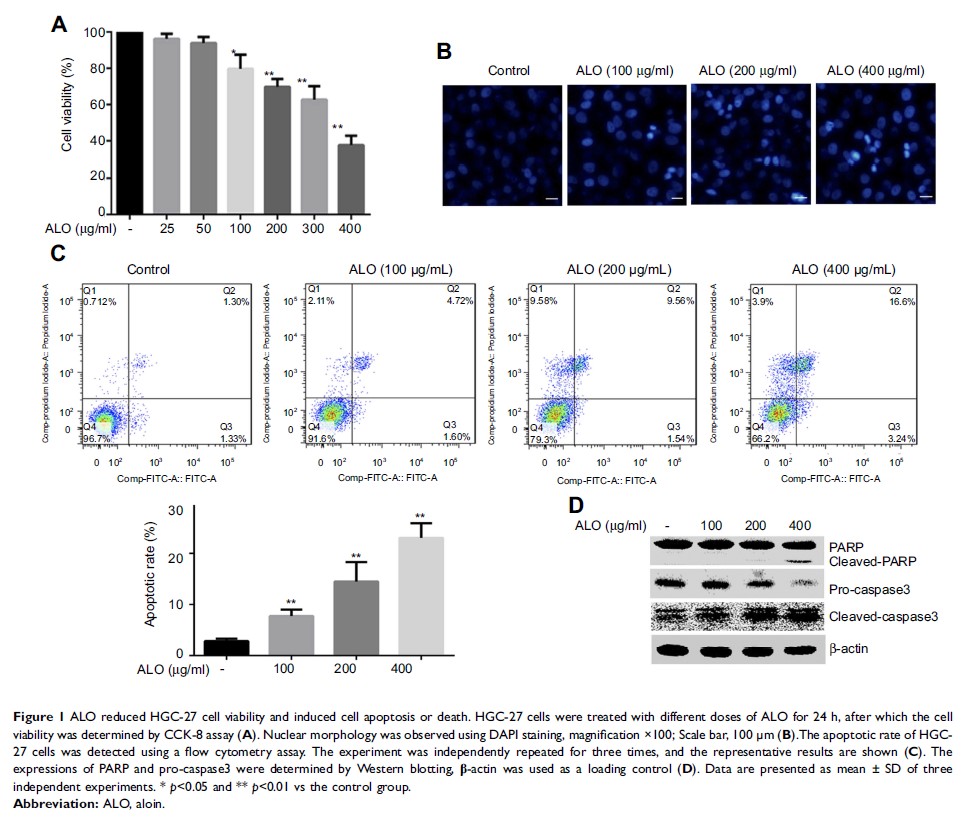9 0 5 7 8
论文已发表
注册即可获取德孚的最新动态
IF 收录期刊
- 2.6 Breast Cancer (Dove Med Press)
- 3.9 Clin Epidemiol
- 3.3 Cancer Manag Res
- 3.9 Infect Drug Resist
- 3.6 Clin Interv Aging
- 4.8 Drug Des Dev Ther
- 2.8 Int J Chronic Obstr
- 8.0 Int J Nanomed
- 2.3 Int J Women's Health
- 3.2 Neuropsych Dis Treat
- 4.0 OncoTargets Ther
- 2.2 Patient Prefer Adher
- 2.8 Ther Clin Risk Manag
- 2.7 J Pain Res
- 3.3 Diabet Metab Synd Ob
- 4.3 Psychol Res Behav Ma
- 3.4 Nat Sci Sleep
- 1.9 Pharmgenomics Pers Med
- 3.5 Risk Manag Healthc Policy
- 4.5 J Inflamm Res
- 2.3 Int J Gen Med
- 4.1 J Hepatocell Carcinoma
- 3.2 J Asthma Allergy
- 2.3 Clin Cosmet Investig Dermatol
- 3.3 J Multidiscip Healthc

通过靶向 High Mobility Group Box 1,Aloin 的分子作用机制可诱导胃癌细胞凋亡
Authors Tao H, Tang T, Wang S, Wang Z, Ma Y, Cai T, Cheng X, Qi S, Zhang Y, Qi Z
Received 16 January 2019
Accepted for publication 19 March 2019
Published 17 April 2019 Volume 2019:13 Pages 1221—1231
DOI https://doi.org/10.2147/DDDT.S201818
Checked for plagiarism Yes
Review by Single-blind
Peer reviewers approved by Dr Palas Chanda
Peer reviewer comments 2
Editor who approved publication: Dr Qiongyu Guo
Purpose: Aloin (ALO), a bioactive ingredient
extracted from aloe vera, has anti-tumor effects. High Mobility Group Box 1
(HMGB1), a highly conserved nuclear DNA-binding protein, has been implicated in
various cancer types. Highly expressed HMGB1 is closely associated with tumor
cells apoptosis, proliferation and migration. We investigated the specific
molecular mechanisms by which ALO-induced apoptosis by targeting HMGB1 in
gastric cancer cells.
Materials and methods: Human gastric cancer HGC-27 cells were treated with different
doses of ALO (100, 200 and 400 μg/ml) for 24 h, after which DAPI
staining was used to observe the nuclear morphology, Annexin V/PI double
staining assay was used to determine the rate of apoptosis; Western blotting
was used to detect the levels of PARP, pro-caspase3, HMGB1 and RAGE; nuclear
translocation of HMGB1 was determined by conducting a nucleoplasm separation
experiment. The Enzyme linked immunosorbent assay (ELISA) assay was used to
detect release of HMGB1. The HGC-27 cells, transfected with HMGB1 shRNA plasmids,
were stimulated with ALO for 24 h, after which a flow cytometry assay was
used to detect the rate of apoptosis. HGC-27 cells were pre-treated with or
without ALO and then stimulated with rhHMGB1, the phosphorylation of Akt, mTOR,
P70S6K, S6, 4EBP1, ERK, P90RSK, cAMP regulatory element binding (CREB) were
detected by Western blotting.
Results: After
different doses of ALO treatment, the nuclei showed morphological changes
characteristic of apoptosis. Apoptotic rates were enhanced in a dose dependent
manner. The level of cleaved PARP was enhanced and pro-caspase3, HMGB1 and RAGE
levels were reduced, HMGB1 nuclear translocation and release were inhibited.
The activation of rhHMGB1-induced Akt-mTOR-P70S6K and ERK-CREB signalling
pathways was inhibited by ALO. Blocking these signalling pathways by special
inhibitors and HMGB1 knockdown could enhance ALO-induced HGC-27 cell apoptosis.
Conclusion: ALO-
induced HGC-27 cell apoptosis by down-regulating expressions of HMGB1 and RAGE,
inhibiting HMGB1 release and then suppressing rhHMGB1-induced activation of
Akt-mTOR-P70S6K and ERK-P90RSK-CREB signalling pathways.
Keywords: Aloin,
gastric cancer, HMGB1, Akt, mTOR, P70S6K, ERK, P90RSK, CREB, apoptosis
